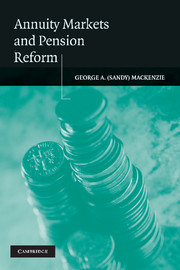Appendix 1 - The Economics and Financing of Annuities
Published online by Cambridge University Press: 13 November 2009
Summary
INTRODUCTION
The text's discussion of the economics of annuities avoids the use of mathematics. This expository device makes the text more readable, but in the eyes of some readers may also diminish the rigor of its arguments. Appendix 1 will use simple models, and in particular a two-period life cycle model to demonstrate that the text's propositions may be rigorously derived. The mathematical demands it makes on the reader do not go much beyond basic calculus. Walliser (2001) is an excellent reference for the economics of annuities.
A TWO-PERIOD MODEL
We assume that potential annuity purchasers may live for as long as two periods. We may think of the first period as working life, and the second as retirement. Everyone lives for at least one period, but some persons die before the second period starts. In the first period, a person earns income, and in the second, if he or she is still alive, must live off his savings from the first period. He may save (i.e. transfer consumption to period two) in one of two ways: by buying a bond, or by buying an annuity. People know they may not survive to the second period.
To begin with, we assume that potential annuitants do not wish to leave a legacy, and that the only uncertainty confronting them is the date of their death. They do not need to plan for unexpected contingencies in the second period, such as ill-health, and the attendant costly medical care.
- Type
- Chapter
- Information
- Annuity Markets and Pension Reform , pp. 194 - 224Publisher: Cambridge University PressPrint publication year: 2006



